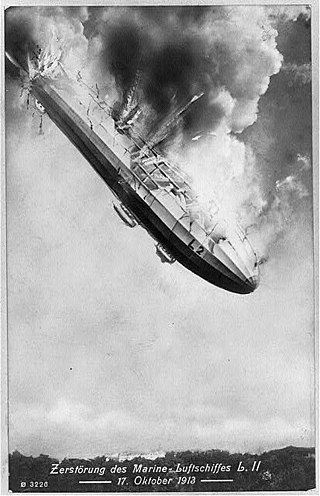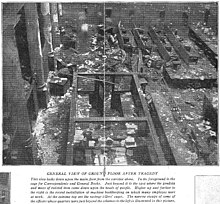
An airship or dirigible balloon is a type of aerostat or lighter-than-air aircraft that can navigate through the air under its own power. Aerostats gain their lift from a lifting gas that is less dense than the surrounding air.
This is a list of aviation-related events from 1919:

USS Macon (ZRS-5) was a rigid airship built and operated by the United States Navy for scouting and served as a "flying aircraft carrier", carrying up to five single-seat Curtiss F9C Sparrowhawk parasite biplanes for scouting or two-seat Fleet N2Y-1s for training. In service for less than two years, the Macon was damaged in a storm and lost off California's Big Sur coast in February 1935, though most of the crew were saved. The wreckage is listed as the USS Macon Airship Remains on the U.S. National Register of Historic Places.

Frederick Karl Gampper Jr. was a dirigible pilot with license #53 issued by the Aero Club of America, and a licensed free balloon pilot. His mentors included Ralph H. Upson and Herman Kraft.

The Goodyear Blimp is any one of a fleet of airships operated by the Goodyear Tire and Rubber Company, used mainly for advertising purposes and capturing aerial views of live sporting events for television. The term blimp itself is defined as a non-rigid airship—without any internal structure, the pressure of lifting gas within the airship envelope maintains the vessel's shape.
Luftschiffbau Zeppelin GmbH is a German aircraft manufacturing company. It is perhaps best known for its leading role in the design and manufacture of rigid airships, commonly referred to as Zeppelins due to the company's prominence. The name 'Luftschiffbau' is a German word meaning building of airships.

Thomas Scott Baldwin was a pioneer balloonist and U.S. Army major during World War I. He was the first American to descend from a balloon by parachute.

The Johannisthal air disaster involved the Imperial German Navy's L 2 airship manufactured by Luftschiffbau Zeppelin as LZ 18. Its test flight resulted in the death of all 28 passengers and crew on board. On 17 October 1913, at approximately 10:30 am local time, hydrogen gas which was being vented was sucked into the forward engine and ignited causing the airship to explode and burn. It crashed near Johannisthal Air Field about 16 kilometres (10 mi) southeast of Berlin. The accident occurred a little over a month after the Helgoland Island Air Disaster.

Goodyear Aerospace Corporation (GAC) was the aerospace and defense subsidiary of the Goodyear Tire and Rubber Company. The company was originally operated as a division within Goodyear as the Goodyear Zeppelin Corporation, part of a joint project with Luftschiffbau Zeppelin, leading to the development of rigid airships in the United States. As part of the failing relationship between the US and Germany in the era prior to World War II, the division was spun off as Goodyear Aircraft Company in 1939. The company opened a new factory in Arizona in 1941 which produced subassemblies, including subcontracted airframe construction and the design of the Goodyear F2G Corsair and Goodyear Duck.

Naval Air Station Rockaway adjoined Fort Tilden on the western portion of the Rockaway Peninsula in the New York City borough of Queens. It was established on transferred municipal property in 1917 during American involvement in World War I.

The B class blimps were patrol airships operated by the United States Navy during and shortly after World War I. The Navy had learned a great deal from the DN-1 fiasco. The result was the very successful B-type airships. Dr. Jerome Hunsaker was asked to develop a theory of airship design, Lt. John H. Towers had returned from Europe having inspected British designs, and using reports from attachés on British airship operations, the Navy was prepared to seek bids for blimps from American manufacturers. On 4 February 1917 the Secretary of the Navy directed that 16 nonrigid airships of Class B be procured. A February 12, 1917 meeting with the Chief of the Bureau of Construction and Repair, and representatives of Goodyear, Goodrich, Connecticut Aircraft Company, Curtiss Aeroplane and Motor Corporation, and U.S. Rubber Company, it was agreed that the order for 16 dirigibles was beyond the capability of any one company. The conference resulted in a committee to coordinate on sharing raw materials, information and experience. Ultimately Goodyear manufactured 9 envelopes, Goodrich made 5 and Curtiss assembled the gondolas for all of those 14 ships. Connecticut Aircraft contracted with U.S. Rubber for its two envelopes and with Pigeon Fraser for its gondolas. The Curtiss-built gondolas used by Goodyear and Goodrich used modified Curtiss JN-4 fuselages powered by Curtiss OXX engines. The Connecticut Aircraft blimps were powered by Hall-Scott engines. One ship, B-20 was equipped with a special control car. All B-Class airships were delivered to the Navy between August 1917 (B-1) and September 1918 (B-20).

Hangar One is one of the world's largest freestanding structures, covering 8 acres at Moffett Field near Mountain View, California in the San Francisco Bay Area.
Airship hangars are large specialized buildings that are used for sheltering airships during construction, maintenance and storage. Rigid airships always needed to be based in airship hangars because weathering was a serious risk.

White City was a recreational area located in the Greater Grand Crossing and Woodlawn community areas on the south side of Chicago from 1905 until the 1950s. At the time of its opening, on May 26, 1905, it was claimed to be the largest park of its type in the United States. It contributed to Chicago's status as the city with the most amusement parks in the United States until 1908. It eventually introduced the world to the Goodyear Blimp, which was first assembled at the park.
A mooring mast, or mooring tower, is a structure designed to allow for the docking of an airship outside of an airship hangar or similar structure. More specifically, a mooring mast is a mast or tower that contains a fitting on its top that allows for the bow of the airship to attach its mooring line to the structure. When it is not necessary or convenient to put an airship into its hangar between flights, airships can be moored on the surface of land or water, in the air to one or more wires, or to a mooring mast. After their development mooring masts became the standard approach to mooring airships as considerable manhandling was avoided.

C-5 was a C class blimp operated by the U.S. Navy in 1918 and 1919. It was one of ten C class hydrogen inflated non-rigid airships constructed by Goodyear and Goodrich primarily for naval patrol duty and training during World War I.
Unlike later blimp squadrons, which contained several airships, the large rigid airship units consisted of a single airship and, in the case of the USS Akron and USS Macon, a small contingent of fixed-wing aircraft.

Paul W. Litchfield was an American inventor, industrialist, and author. He served as President, Chairman, and the first CEO of the Goodyear Tire & Rubber Company and the founder of the town of Litchfield Park, Arizona and the city of Goodyear, Arizona. Among his many accomplishments as chairman was the establishment of a research and development department that produced the first practical airplane tire, long-haul conveyor belts, hydraulic disc brakes for airplanes, the first pneumatic truck tire, and a bullet-sealing fuel tank for military airplanes. Litchfield was also the author of books on air power, trucks, employee relations, and business.














